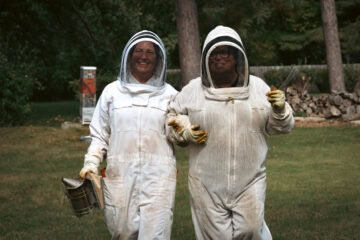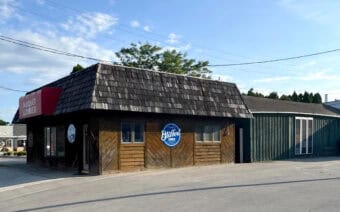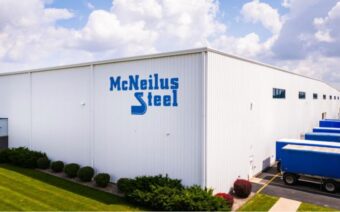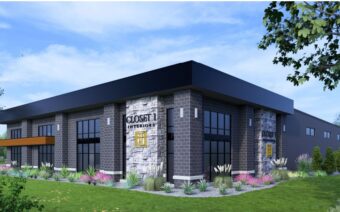
March 5, 2024
DE PERE — Every year, the Sheet Metal and Air Conditioning Contractors National Association (SMACNA) recognizes contractors who it sees as visionaries, game-changers and the driving forces behind continuous improvement.
This year, the 2024 SMACNA Innovator of the Year Award was presented to Chris Hronek, construction technology manager at Tweet/Garot Mechanical.
Presented at the 2024 MEP (mechanical, electrical and plumbing engineering) Innovation Conference — which is considered in the industry as the preeminent technology conference for mechanical, electrical, plumbing, service and sheet metal contractors — this award recognizes excellence and celebrates those who are transforming and shaping the future of their industry.
A tenured career
Hronek began at Tweet/Garot 22 years ago as an apprentice sheet metal worker.
The 41-year-old said he worked his way up to a journeyman sheet metal worker before being promoted to the role he has now.
“Chris is an incredibly skilled sheet metal worker who combines his trade expertise with a keen interest in technology to spearhead the digitization of the fabrication process, specifically focusing on optimizing shop workflows,” Linda Jennings, executive director of innovation, integration and learning at SMACNA, said. “(Hronek) is also a valued resource throughout Tweet/Garot and the industry, always going above and beyond to share and promote new and innovative workflows.”
Tweet/Garot CEO Chris Howald said he’s proud to have Hronek as part of the team.
“I’m grateful (Hronek has) helped shape our digital transformation and worked as a change agent to grow adoption with all our employees,” he said. “(Hronek is) a wonderful resource for other companies with similar challenges. I know this is the beginning of the recognition that (his) innovation and leadership will bring in the future.”
Digitizing the shop for greater efficiencies
SMACNA’s recognition, Hronek said, was not for one specific thing, but several things combined.
“My team and the company as a whole have a good innovative culture that allows us to do a multitude of different tasks,” he said.
Hronek said Tweet/Garot has been using technology programs called Stratus and Field Orderz to digitize its operations, specifically for data collection and doing field orders.

Chris Hronek
He said he spearheaded efforts to get Tweet/Garot to adopt the programs company-wide.
Specifically, he said Stratus benefits construction project management by providing a comprehensive, user-friendly platform that enhances collaboration, streamlines document control and offers valuable insights into project performance.
It allows construction contractors to not only overcome challenges but also improve productivity and deliver projects on time and within budget.
“The industry has talked about big data for several years,” he said. “We have a lot of data, but historically, we haven’t been able to do a lot with it. But now, with the use of artificial intelligence (AI), we’ll be able to start picking that apart and do something with it.”
Hronek said one of the things he worked on last year was digitizing the shop.
“So, (at one time), we had old paper drawings that might have been on a napkin or even a blueprint where something changed, got torn, smudged or whatever,” he said. “Now our shop teams are using digital platforms — computers and TVs — where they’re using the latest model, so they have the most current information, and it’s accurate and readily available. In the case of digitizing the shop, it’s a good initiative from an efficiency gain by having the latest content and latest information on what they’re drawing and accurate materials of what they’re fabricating.”
Hronek said Tweet/Garot started digitizing efforts in November 2021 — beginning with the office and then moving on to the shop.
This process, he said, was divided up by trade — doing sheet metal first, then piping and lastly, plumbing.
Despite the main digitization process finishing in 2023, Hronek said it’s a fluid process that will always be evolving and growing.
Savings of time and money
Digitization, Hornek said, will help eliminate mistakes in calculations — just one way Tweet/Garot is saving time, and therefore, money.
“As part of being digitized, we are printing labels for the material we are shipping (out to customers or job sites),” he said. “It’s tracking progress from different steps in the shop and different steps in the field, all the way to installation. Those labels printed have a QR code that ties back to the model. It tells us the status of a (job).”
For example, Hronek said, “say we’re sending out a pipe spool.”
“(In the past), there’s a tradesperson who is writing out by hand with a Paintstik where it goes, what it is, what the job number is, what the weight is, all kinds of information,” he said. “That now all comes on a printed label. So, in a scenario of the release of 65 spools, when I showed one guy how to print a label, it took 30 seconds, maybe a minute, at most.”
Hronek said that alone would have been two days of that one guy writing everything out by hand.
“So, 16 hours of one tradesperson writing things by hand is now being done in a minute or less,” he said. “And the label has more information than when doing things by hand. That’s not a daily thing, but it is one quantifiable case of the benefits of having a label on something and having it done digitally, as opposed to handwriting it.”
Another benefit of being digitized, Hronek said, is eliminating project downtime.
“That could happen because second-shift has questions about a drawing, but can’t get answers from the office staff because it’s late at night and the office is closed,” he said. “Now, we can go to the (digital) file and manipulate it and pull the measurement ourselves and continue working.”
Hronek said digitization is helping Tweet/Garot track progress in the shop, in the field and through the installation process.
In general, he said, it’s about making things better, faster and stronger.
“In a continually shrinking workforce, innovation allows us to get the work done in the same amount of time with fewer people — not replacing those people, just making their lives, their work, easier (by reducing the amount of time it takes someone to do certain tasks),” he said. “The use of AI is helping make programming and other tasks easier without needing to have an entire tech company at your disposal.”
Hronek said the digital workflow now shows the company exactly how many hours the team put in at the shop or field areas.
“Being able to track work even more granularly, we can figure out exactly where the bottlenecks were,” he said. “What piece of the project was (causing a problem)? Was it a particular machine that caused us to fall behind or was it something else?”
Not always an easy sell
In an ever-changing world and more reliance on technology, Hronek said there will always be people who don’t trust that technology is going to be a good thing — not something that’s going to land them on the unemployment line.
Additionally, he said as humans, we often tend to resist change.
In his case, Hronek said he used his background as a laborer to bring people around to the idea of digitization.
“I think what allows me to be successful in (convincing workers of the benefits of digitization) is because I try to frame my words in such a way that shows I’m one of them,” he said. “I came from the trade — I did the work, and I’ve lived those experiences they are.”
Hronek said he believes his approach has been successful because he’s been able to use “shop language.”
“I’m trying to help because the topics, ideas and things I’m passionate about and trying to change for the better, are all things I lived first-hand a few years ago,” he said. “There were some naysayers, but with a lot of the things we’re working on, I’m able to flip them. I’ll talk to them first because the worst critic is the best person to try to change. If I’m implementing something new and I know it’s going to be hard, I could go to the easiest person who’s going to say ëyesí to everything, kind of like I used to. Or I could go to the guy who says ëthis is never going to workí first. If I can change him, then I know we’ve got something good going on and I can more easily convince others.”

Chris Hronek, left, the construction technology manager at Tweet/Garot Mechanical, discusses digital work instructions and labels for a duct spool with HVAC Shop Foreman Aaron Blake. Submitted Photo
In the end, Hronek said the digitization project has been easier because he not only has executive support, but the support of people in the shop and in the field, as well.
“Overall, I think the company has been wonderful — I couldn’t have done this without the support below and above me,” he said. “My job is easier because I have executive support and the support of the people doing the work and who we’re making the changes for. And it’s good, overall, to see the construction industry trying to catch up to the manufacturing industry and benefitting from the efficiency (digitization) provides.”
In general, Hronek said he believes automating any areas they can that will help with greater efficiencies and cost-savings is a good thing.
“But I want to stress, these things are not meant to replace any workers,” he said. “But knowing we have a labor shortage upon us — with the retirement of the Baby Boomers and (young people) not getting into the trade — the stuff we’re automating, in general, helps the industry prepare for that shortage of boots on the ground labor.”
Hronek said many of the things Tweet/Garot is working on is trying to streamline and automate processes so it can do things faster and more efficiently which, in turn, “has benefits all around.”
“But a lot of the other processes are making our day-to-day tasks easier,” he said. “I plan on continuing to evolve what has been doneÖ We plan on continuing to modify and figure out what’s working and how we can make things better. But (what we are developing today) is tomorrow’s reality.”
Benefiting the industry as a whole
Hronek said he relishes the opportunities to share his passion for the industry with others.
“When I have opportunities to go to a trade show, it’s refreshing to have conversations with peers in the industry from all over the country and not worry about giving away trade secrets, helping your competitor or worrying about someone taking my job,” he said. “We’re all in the same boat, and a lot of our struggles are the same. I think it’s important and eye-opening to have a conversation (with others about the same problems). When all the trades come together to discuss their similar (and mutual) problems, we can come to a unified solution.”
Hronek said he was humbled to be in the spotlight but would rather share it with others — in fact, he thinks the reason he won the award is because he’s willing to share with others.
“I’m not a closed book,” he said. “When it comes to sharing what we’re doing and why we’re doing it, I’m open amongst peers in the industry to share the wins and losses.”
At the end of the day, Hronek said they are all trying to accomplish the same thing.
“I’m all about helping someone — and maybe they’ll someday be able to help me,” he said. “Helping each other makes the industry better as a whole. I enjoy things when we’re all successful.”
 Kundinger Inc. partners with AUBO Robotics USA
Kundinger Inc. partners with AUBO Robotics USA Bringing flavor straight from the hive
Bringing flavor straight from the hive








